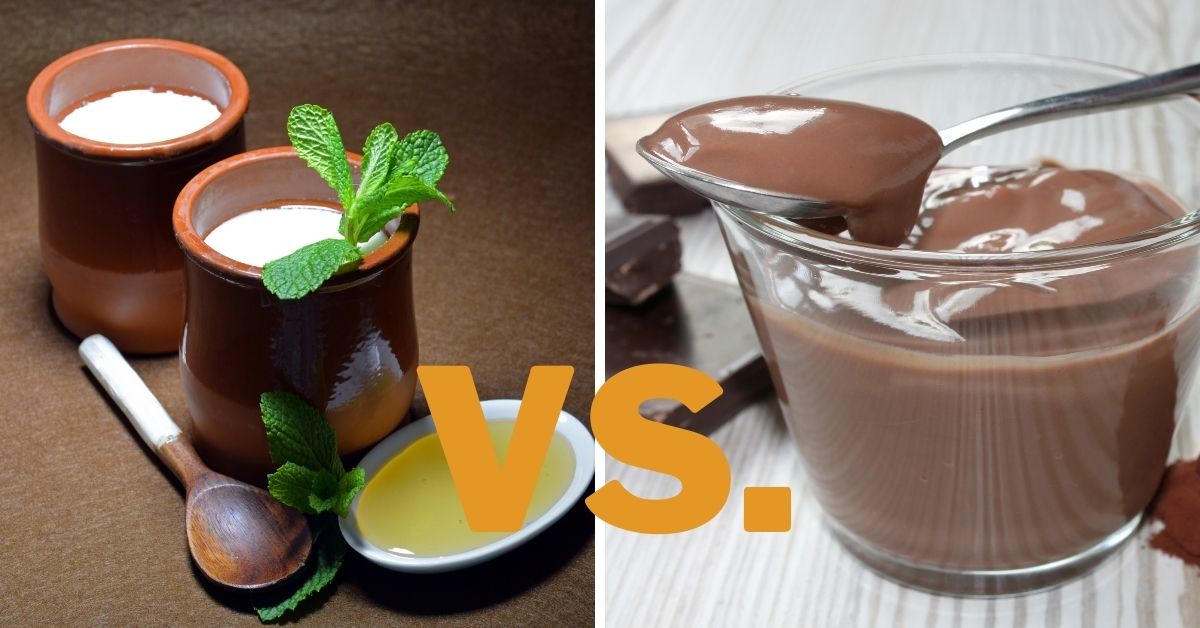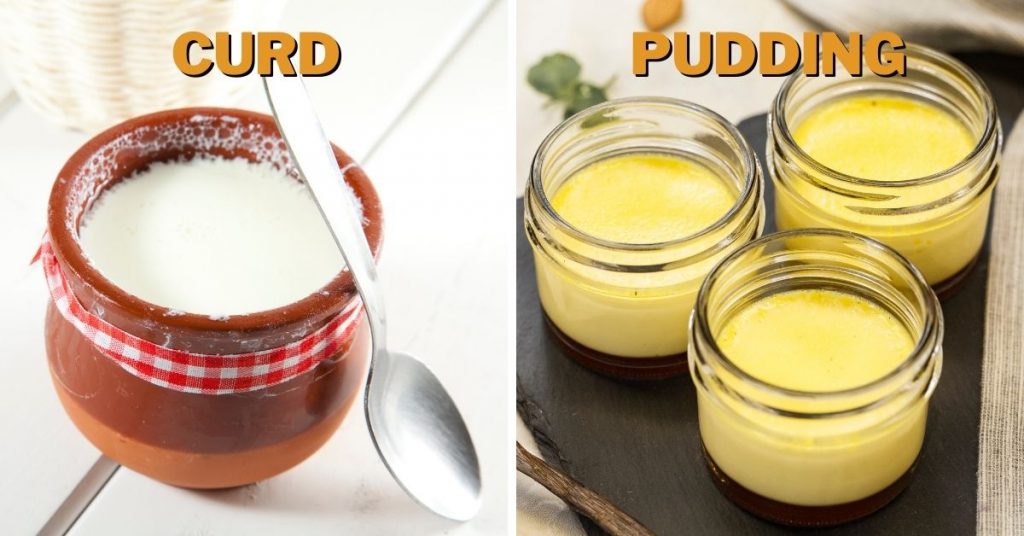Curd vs. Pudding: Differences & Which Is Better?

Available in every store and very easy to make at home, both curd and pudding are very commonly used and a frequent guest in many kitchens. Still, one can be confused about their differences and uses, for example in a dessert. So, what are the differences between curd and pudding, and which is better?
Curd and pudding are dairy milk products, so they have the same root ingredients but no other common ones. While curd is essentially coagulated milk, pudding is thickened milk. To make curd, acidic agents are added to the milk, and for the pudding, you need thickeners.
Curd and pudding have entirely different uses, but in some cases, they overlap, even then, they are very welcome in my kitchen. Pudding is irreplaceable for me when I crave something sweet and creamy, but curd is my go-to solution when I need something zesty, creamy, and mildly tangy. In the following paragraphs, I will explain the differences between curd and pudding, which is better, and what you can substitute them with.
Curd vs. Pudding: Differences
Although both creamy and soft, curd and pudding are entirely different. Other than their root ingredient- milk, they don’t have much else in common.
Curd and pudding differ in taste, production, and nutritional value, but they also differ in texture, although significantly less compared to the other aspects.
Taste
Because they go through different production processes, curd and pudding taste entirely different.
Curd is coagulated milk, and pudding is thickened milk. The milk is mixed with acidic elements, such as lemon juice, vinegar, or rennet, which trigger the coagulation process to obtain curd. Also, coagulation is a natural process of the milk, so it will thicken on its own if left 72 hours at room temperature.
The curd can either be a finished product or the initial stage of cheese production. Because curd is coagulated milk, it is only natural that it is mildly tangy, salty, soft, and creamy.
Curd also contains very discrete amounts of salt, but it isn’t salty per se. The amounts of salt in the curd are enough to amplify the other flavors, but not to define its taste as salty. Therefore, the curd is s mild and neutral-tasting, with a whisper of tanginess, sourness, and zest.
Pudding, on the other hand, is an entirely different story. The milk is thickened with a flavored thickener which determines the taste of the pudding. Depending on the thickening agent, the pudding can taste like vanilla, strawberry, chocolate, or any other flavor the thickener has.
However, regardless of the thickener’s taste, the pudding is always sweet and a dessert by itself.
Texture
The only similarity between curd and pudding is in their texture. They are both creamy and smooth, but pudding is thicker, while the curd is more watery.
Again, their textures are similar but not identical because of their different production processes. Pudding is thicker than curd, which is expected since it is purposely thickened.
On the other hand, curd contains more liquid and can be runny. While pudding would slide off, curd would drip. Of course, they both tend to get thicker when chilled.
Nonetheless, both curd and pudding are very pleasant for the palate, and both are rich and full.

Nutrition
Nutrition is another aspect where curd and pudding differ because curd is generally more nutritious than pudding.
High in protein and low in carbohydrates, the curd is an excellent keto diet addition. Curd is also rich in vitamins such as vitamin B, C, A, riboflavin, and minerals such as calcium, potassium, zinc, and phosphorus. [1]
In general, a curd is a healthy option, and it should be a part of your regular diet. It is moderately fat and moderately caloric, which, combined with its other nutrients, makes curd a very healthy option. In addition, the lacto bacteria make curd very beneficial for gut health.
On the other hand, pudding is very high in sugars, meaning that it also contains carbohydrates. It is, however, slightly more caloric and fatty than curd but is significantly less rich in nutrients such as vitamins and minerals. [2]
The amounts of vitamin B, C, and A in the pudding are much lower than in the curd. Furthermore, pudding isn’t a good choice for the keto diet or on a weight loss journey.
Therefore, the pudding shouldn’t be on your daily menu, but it’s perfectly ok to consume once or twice a week in moderate to low amounts.
Use
In terms of use, curd has a more versatile use than pudding. Considering that curd is neutral-tasting, it can be an excellent addition to sweat, as well as savory dishes. Curd goes great as baked goods topping, as a salad dressing, in cheesecakes, fruit salads, fruit smoothies, as well as plain.
Pudding has much more restrictive use than curd. Because of its expressively sweet flavor and thick consistency, you cannot use pudding in savory dishes, nor can you use it as a sauce or in smoothies.
Pudding is a dessert by itself, and you can add whipped cream or a fruit topping to make it even richer. Still, you can use pudding in desserts as an ingredient, such as cookie topping or cake filling. You can also make a layer of no-bake cake using pudding and biscuits of your choosing.
While curd offers many more opportunities than pudding, it is irreplaceable in its domain. Although used only for desserts, pudding combines very well with products from this category and offers a variety of options.
Curd Vs. Pudding: Which Is Better?
It would be a mistake to say that one is better since both have qualities and weaknesses. They are irreplaceable in their use and have their established places. However, the healthier option would be curd, but the tastier is totally up to you.
Can You Use Lemon Pudding Instead of Lemon Curd?
The short answer would be – sometimes. Pudding is not something you can bake. Since lemon curd is mainly used in lemon meringue pie which requires baking, lemon pudding could not substitute for that.
Moreover, the taste of lemon pudding cannot substitute for the zest and freshness of the lemon curd. Still, if the dessert doesn’t require baking, you can substitute lemon pudding for lemon curd.
What Can Be Used Instead of Curd?
Depending on the purpose, there are a few suitable substitutes for curd. Crème Fraiche can substitute curd for baked good spread, salads, or smoothies. Heavy cream can substitute curd for sauces and dips, and sour cream is a good solution for fresh and zesty foods.
